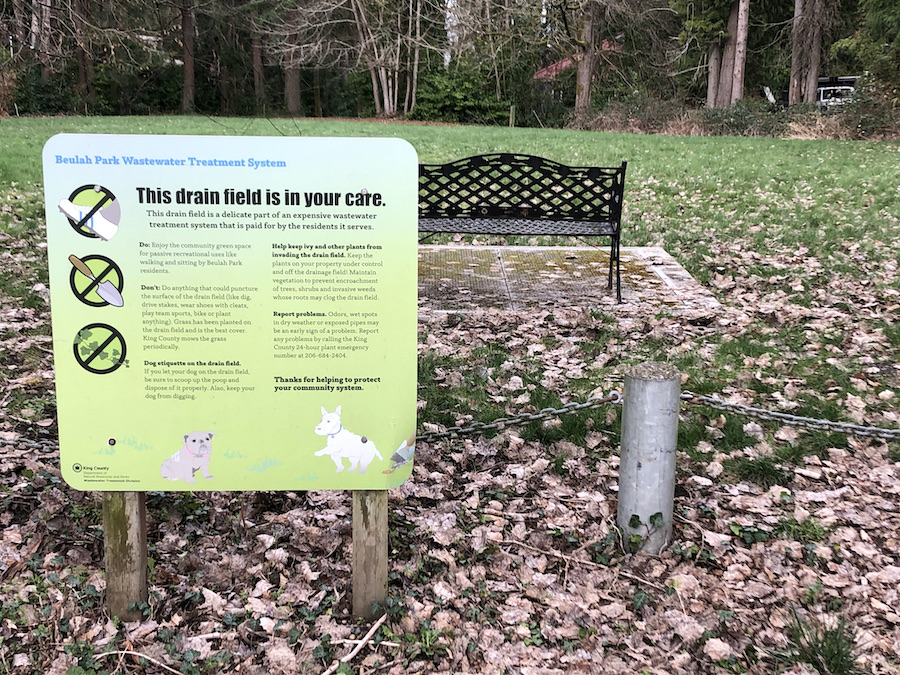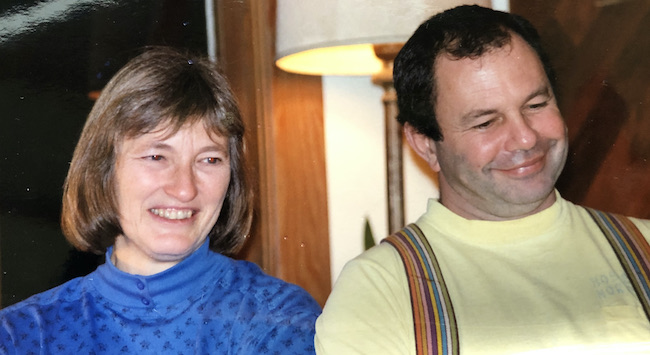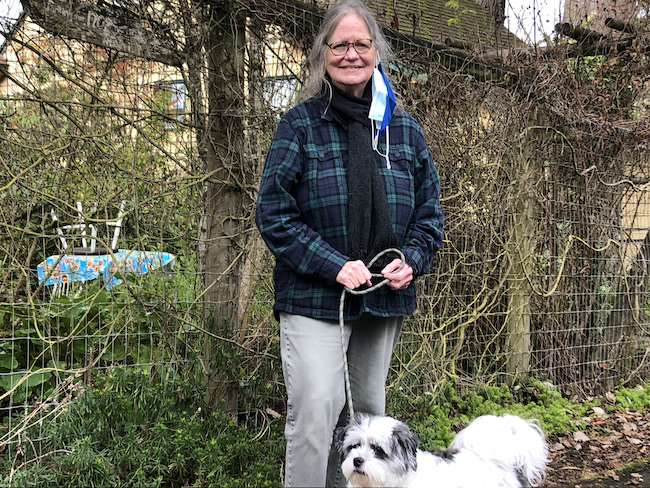written by: Mary Bruno
This is the fifth in a monthly series of guest blog posts that Mary will be sharing about island water quality topics thru the Groundwater Protection Committee.
This is a story about how three neighbors saved two Vashon neighborhoods.
The story begins in 1989 when the Washington State Department of Health (DOH) surveyed septic systems in Beulah Park. Forty-two vintage bungalows snuggle together on a ridge in that North End neighborhood. All but one of their septic systems were failing. DOH crews found sewage in nearby streams, in basements and on the beach. It wasn’t really a surprise, recalls Patty Daughtry, who has lived in Beulah Park for 38 years. “You could smell the problem.”
In July 1990, DOH declared Beulah Park a Health Hazard Area. Ditto the 13-home Cove neighborhood on the waterfront below. Homeowners got the news in a letter from DOH saying that they wouldn’t be able to sell, upgrade or rebuild their houses unless they fixed the septic problem. The letter didn’t come with a roadmap or any guidance about how. “It felt like we’d been hit with an avalanche of trees and mud,” says Patty. “Nobody had any idea what to do.”
The only Beulah Park home whose septic system passed the DOH inspection belonged to Mark and Carol Salkind. Natives of rural New York State, the Salkinds arrived in Beulah Park in 1974. Their 1920s-era home sits on one of the neighborhood’s largest lots. “We had room to have our own septic system,” says Carol Salkind. “But Mark was very community spirited. He just felt that it was better if something was done for everybody. So we decided we’d see what we could do.”
So began an 11-year journey that ultimately—SPOILER ALERT!—saved both neighborhoods.
Mark Salkind was a newly retired engineer, who had served as a civilian project manager for the US Navy. He was comfortable with technical challenges and he knew how to work a problem—and work it and work it and work it. But the Beulah Park/Cove septic challenge would prove daunting even for Mark Salkind. Most of the neighborhood lots were too small for new individual systems. The problem demanded a creative, communal solution. Which meant commissioning a custom engineering design, getting it permitted, built, paid for and, well, you can imagine. “It was pretty intense,” says Carol. “We had boxes of [project-related] stuff all over the house.” The good news was that the neighborhood’s Health Hazard designation opened up government funding opportunities.
Acting on a tip from a DOH official, the Salkinds first petitioned the Vashon Sewer District to adopt the project and the neighborhoods. (The District agreed, and would eventually recruit Mark as a commissioner.) The Sewer District association helped the Salkinds land a $2 million grant from the State Department of Ecology. That money paid for the initial engineering study and part of the subsequent design and construction cost. The eventual design, a kind of sewer-septic hybrid, was so original that its chief engineer (John Wilson of Earth Tech of Bellevue) presented it at an international engineering conference in New Zealand in 2000. The design featured new “vacuum chambers”—one for every two homes—a vacuum sewer line, a sophisticated wastewater treatment plant, a drain field and all the gauges, pipes, pumps and sensors that connected the various pieces and made them all work. Price tag: about $10 million.
The project was a team sport. The players included the Vashon Sewer District, King County and the Beulah Park/Cove communities. Here’s how it worked: The Vashon Sewer District installed and maintains the vacuum chambers that hold the waste and the vacuum sewer line that whisks it to the treatment plant in the ravine behind the Salkind’s property. King County manages the treatment plant along with the drain field up above. Once wastewater reaches the plant, it travels through three septic tanks, a gravel filter and an ultraviolet (disinfectant) chamber before it’s pumped back uphill to the drain field where a drip irrigation system provides a final polish. The result is “the equivalent of tertiary treatment,” Mark Salkind proudly told Seattle’s Daily Journal of Commerce in 2000.
“This [system] is very unique, on several fronts,” says Vashon Sewer District manager Jim Gross. From its hybrid design to its advanced treatment to its operating arrangement between the County and the Vashon Sewer District. (Only two other communities in Western Washington have similar vacuum sewer systems: Carnation and Ocean Shores.)
Beulah Park Cove residents were responsible for connecting their houses to a vacuum chamber, and for contributing to the cost of the community system. Each household’s community share was based on how much the new sewer-septic system would add to a home’s assessed property value. Fortunately, generous grants from the state Dept. of Ecology and 20-year, no interest, no-money-down loans from King County covered the sizable community investment. Patty Daughtry, for example, paid $3,500 up front for her house-to-chamber hookup (a pipe). Payments on the $35,000 loan for her community share ran about $1,800 a year for 20 years. Patty retired her loan in 2018. These days, she just pays the Vashon Sewer District $145 every two months to maintain her vacuum chamber and the vacuum sewer line.
As Mark and Carol sweated logistical details, Patty tackled community outreach. A neighborhood solution required every household to get on board. Patty was at home with a new baby girl. She started knocking on doors. Her mission: “Convincing neighbors that yeah it was scary as hell and yes it was an unknown debt, but if we don’t all try to get on the same page, what’s at stake is our home.” Smart, funny, warm and patient, Patty was the perfect ambassador. She explained, cajoled and ultimately convinced her Beulah Park and Cove neighbors, all of them, to embrace the project. It took her six years.
There would be other hurdles: acquiring the vacant lot at the corner of Tabor Avenue and SW 172nd Street for the community drain field; getting archeologists to certify that the lot was free of Native remains; satisfying U.S. Fish and Wildlife that no eagle nests would be disturbed during construction of the treatment plant. “It just was one thing after another,” recalls Carol. “But it was a challenge, and Mark wouldn’t give up.”
Mark Salkind died in July 2018, not long after his 80th birthday. The hybrid system that he helped create had been humming along for almost 20 years by then. A solitary bench sits at one end of the grassy, unfenced drain field. Its bronze plaque reads: “Dedicated to Mark and Carol Salkind, with great appreciation, your Beulah Park neighbors.”
Saving their homes and the neighborhood they love was a tremendous reward for all the hard work, says Patty. But in the end, “What is most cool is that because of Mark and Carol the sewage from all these houses is not percolating or dumping into Puget Sound. That is the real win!”
Featured photo: The Beulah Park drain field is one piece of the community’s unique septic-sewer system.




What a great Article. Fascinating to learn about a Team effort that led to a long term Solution for both the neighbors and the water quality of Puget sound.
Thanks Tom. I agree. I have lots of admiration for the folks involved in making this happen. And thanks Mary for writing it up for us all!
Bianca
Very INTERESTING. People working together saving what they love. So blessed to live on this island
I agree!
There is nothing like the smell of success. Or lack there of.
Ha ha! Steve 🙂
Would you be willing to let the beachcomber publish these Articles? If so, give them a call. Great for the community to read I think.
Hi Gini, Yes, thanks! The Beachcomber does follow this blog and they occasionally pick up stories from it. They also used to have a link to our blog on their on-line Beachcomber site. I am not sure that still exists though as they’ve since redone their website. I will check in with them.
That was a terrific, heartening story. Thanks mary!
I continUe to be So impressed With the INTEGRITY Of the People on this island. So very glad i made the leap!
Great story!
I had heard bits and pieces OF THE STORY BEFORE BUT NOW I GET THE BIG PICTURE AND THE DETAILS. I LIVE HERE SO THANKS TO ALL THE FOLKS THAT CAME BEFORE US SO WE COULD HAVE A SAFE NEIGHBORHOOD!
What really struck me about this 11-year-long effort was how resourceful, persistent and generous Mark, Carol and Patty were. Carol and Mark could have just installed their own septic and called it good. Patty could have just sat back and let the Salkinds do all the work. Instead, they jumped in. I so admire that spirit. Wish we could bottle it.
THIS is incredibly informative and useful information. really inspiring for anyone facing getting all neighbors to approve any action of any kind!
Yes, it is quite remarkable!
My husband and I came to beulah park in 1973–a jump-off place, we thought, to eventually getting some piece of acreage and building our own home. Instead , in good part because of our neighbors, we felt we could not leave beulah park and instead, like most of them, embarked on remodeling (much of which was never finished). We’ve been through a lot since then, but in good part because of Mark, carol and Patti, we have gratefully hung in there and felt so lucky to be hear. I cannot imagine leaving here now. thank you, mary bruno, for writing this piece and ongoing gratitude to mark, carol, patti. shelley calabrese
Shelley what a heartening story. Thanks for sharing. This article and the comments restore my faith in community and humanity. I agree, thanks to Mary for writing this up!
Wow, what a great series of articles about our groundwater and the future of our beloved island. Heartwarming, informative and inspiring. This is why I’m proud to call Vashon my forever home. Thanks to the Nature Center, to you, Bianca Perla, and thanks to Mary Bruno for your great skills as an interviewer, writer and human being!
I am glad to know about this site, Bianca. Marc and Carol’s home was my first home when I arrived on vashon in 1971, not long, I guess, before the Salkind’s moved in. We called it the “Cove house” and we and our family and friends have fond memories of all the good times we had there that year. We were three guys in their 20’s. REnt: $150/mo
What great memories! Thanks for sharing Terry!
Mary, you told us the story so well. Thanks to the community for stepping up together!